Wisconsin Has New Pesticide Problem
Huge farms use pesticide-coated seeds that devastate bee colonies and cause other harms.
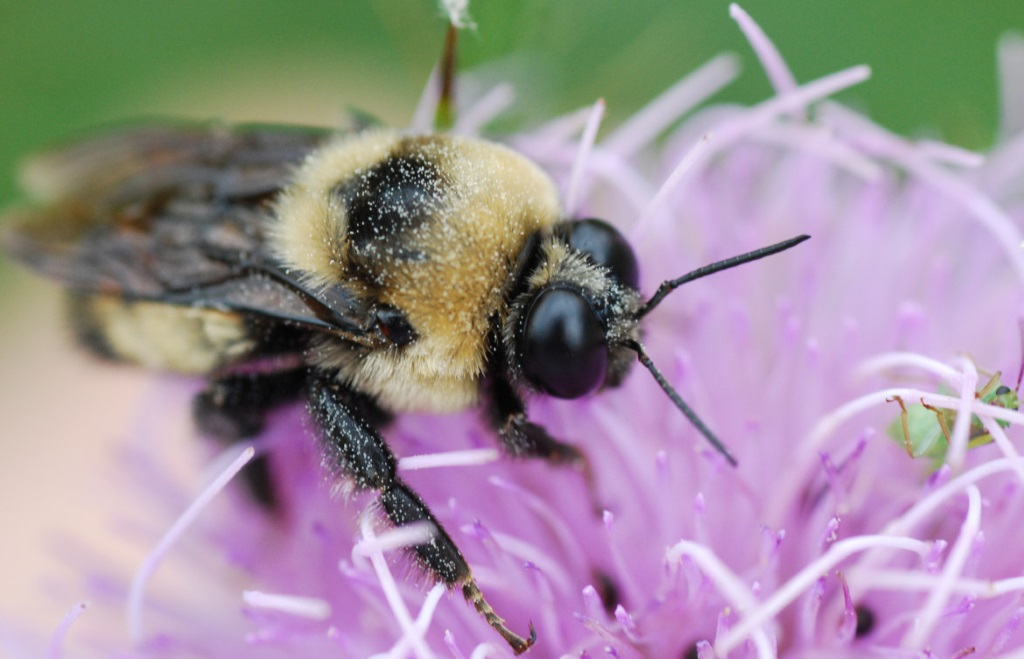
A bee lands on a flower at the University of Wisconsin-Madison Arboretum. Wisconsin has developed a proposal for protecting bees and other pollinators, including butterflies. Critics say it does not focus enough on limiting use of a class of insecticides known as neonics that has been tied to bee die-offs. Photo by Joshua Mayer/via Flickr.
Packed into brains the size of a sesame seed, bees’ navigational systems enable them to locate and pollinate $55 million worth of Wisconsin crops annually.
But Wisconsin has become a hard place to be a bee.
The state’s honeybee colony die-off rates, among the highest in the nation, last year were around 60 percent. Beekeeper surveys show 15 percent is generally considered to be an acceptable loss rate.
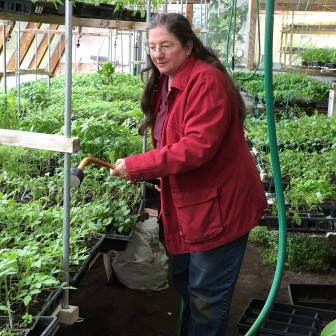
Beekeeper and organic farmer Harriet Behar waters plants in her greenhouse in Crawford County last year. Behar is critical of Wisconsin’s proposed plan to protect state bee populations, which have some of the highest winter die-off rates in the country. She says the plan does not do enough to encourage practices that could lead to less pesticide use. Photo courtesy of Harriet Behar
Wisconsin pollinator populations have been declining for years, endangering the growth of apples, cranberries, cherries and many other fruits and vegetables that rely on bees, butterflies and other pollinators to fertilize them, helping them produce seeds and fruit.
And critics say a recently issued draft of a pollinator protection plan for Wisconsin may offer only limited relief for the insects. The plan recommends voluntary actions such as increasing roadside plantings and pollinator-friendly home gardens, but sets no targets for decreasing the use of a controversial class of agricultural pesticides, neonicotinoids, that attack insects’ brains.
“If it’s all voluntary, it’s basically something that no one has to follow, so what is the point?” asked Harriet Behar, an organic farming specialist with the Midwest Organic and Sustainable Education Service, a nonprofit that promotes sustainable agriculture. Behar keeps 25 beehives on her 216-acre farm in Crawford County in southwestern Wisconsin.
Many scientists and beekeepers including Behar believe large-scale farming practices for crops such as corn and soy — which together represent a $2.6 billion industry in Wisconsin — are important contributors to pollinator declines.
“Corn growers, soybean growers don’t need pollinators, so (they) may be less sensitive to the impact their chemicals have on the rest of the environment,” said Claudio Gratton, professor of entomology at the University of Wisconsin-Madison, who worked on the pollinator proposal for the state Department of Agriculture, Trade and Consumer Protection.
Endless acres of corn and soy with few flowering plants to provide pollen or nectar leave pollinators with little to eat. For wild bees that build their homes underground, there are few undisturbed places near flowering plants to nest. Other factors such as parasites, pathogens, beekeeping practices that may spread viruses and extreme weather, including drought and severe cold, also can take a toll on bees. There are also pesticides, including so-called neonics, which act like nicotine in how they target the insect brain.
Pesticide use widespread
Introduced in the 1990s as more targeted toward specific pests and less harmful to humans and wildlife than older, more toxic insecticides — including organophosphates such as parathion and malathion — neonics quickly grew in market share and have become the most widely used insecticides worldwide, with billions in annual sales. Politically powerful agrochemical interests, including insecticide maker Syngenta, are among the largest producers of neonics. Representatives of Syngenta and the industry trade association CropLife America helped draw up Wisconsin’s pollinator plan. They insist the link between bee population declines and proper use of their products has not been made. Neonics can be delivered through spraying, by injection, such as into tree trunks, by drenching the soil around plants and by coating seeds with it before planting.
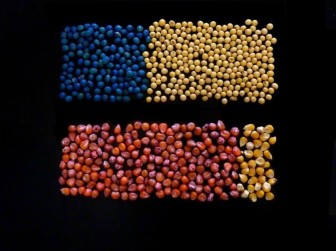
Farmers have dramatically increased the use of a class of insecticides called neonicotinoids, primarily through pesticide-treated corn and soybean seeds. The image illustrates the estimated proportion in 2011 of treated versus untreated seeds nationwide. At top are blue treated soybean seeds compared to untreated soybean seeds; below are treated red corn seeds versus untreated corn seeds. Photo by Ian Grettenberger of Penn State.
Seed coating is the biggest factor driving increased use of neonics. In January, a group of farmers, beekeepers and advocates filed a lawsuit against the United States Environmental Protection Agency for exempting neonic seed coatings from regulation. The plaintiffs say the lack of regulation will harm pollinators and the environment.
By 2012, virtually all corn seed, and about 30 percent of soybean seed planted in Wisconsin and across the country, was coated with neonics, said Paul Mitchell, a UW-Madison associate professor who co-directs the UW-Extension’s Nutrient and Pest Management Program. Neonic-coated seeds also are widely used on other crops such as potatoes and in lawns and gardens.
Neonics are systemic, meaning they are absorbed and remain in the tissue of the plant. They are also potent neurotoxins. Neonics are chemically designed to attack the nervous system of pest insects that eat any part of a treated plant, causing paralysis and death.
With widespread reliance on neonics, unintended exposures to beneficial insects such as pollinators can happen.
Seeds coated with neonics have become sort of an insurance policy for many farmers, said Gratton, who along with Christina Locke, a postdoctoral researcher in Gratton’s laboratory, worked on the pollinator plan.
“Ag practices depend on us taming nature. Farmers don’t like variability and uncertainty,” Gratton said.
“With neonics, there is less application since it’s present in the plant the entire season; it’s a one-and-done idea. Overall there is less used, but there are also a lot of unintended consequences.”
Scientists have identified multiple routes by which beneficial insects such as bees suffer unintended exposures to neonics, even if they are not feeding on the treated plants, as a pest might.
Bees can be exposed through the pollen or nectar of treated plants, by coming into contact with dust kicked up by planting treated seeds, by contacting droplets of water on plants, and by visiting flowers and other plants unintentionally contaminated through neonics’ persistence in soil and water.
It is clear that high enough doses of neonics — such as those that occur from accidental exposures during spraying — can kill bees. Questions about neonics center on lower-level exposures, like those bees might encounter in a field of treated corn or soy.
Pierre Petelle, a vice president of CropLife Canada, wrote in a 2014 blog post on the industry group’s website that many of the lab studies used to justify restrictions expose bees to “unrealistically high doses of neonics.”
David Flakne, a representative of Syngenta and one of the stakeholders invited by DATCP to contribute to the pollinator plan, said neonics are safe when used as directed.

This beehive, wrapped in black plastic to hold in heat, is one of 25 hives Harriet Behar keeps on her Crawford County farm. Photo by Bridgit Bowden of Wisconsin Public Radio.
“Scientific evidence clearly shows that bees and other pollinators can coexist safely with modern agricultural technology, such as neonic insecticides, when product labels are followed,” Flakne wrote in an email to the Wisconsin Center for Investigative Journalism.
Growing evidence of harm
Scientists say while there are multiple causes of bee declines, studies continue to emerge that question whether bees and neonics can safely coexist at field-realistic exposures. By binding to receptors in bees’ brains, some research has found, neonics seem to scramble their sophisticated mental circuitry.
One study of honeybees that were exposed to nonlethal levels of neonics showed they were both more likely to have trouble navigating back to the hive and less likely to survive than unexposed bees. Numerous studies found that both wild and managed bees exposed to neonics showed a reduced ability to find food, weaker brood development, reduced memory and more vulnerability to disease, according to a 2013 paper by European researchers funded by several environmental foundations.
An international task force that examined more than 800 peer-reviewed studies concluded that the widespread use of neonics and a similar systemic insecticide, fipronil, are important contributors to the decades-long trend of declining populations of pollinators and other insects, which are “vital to food security and sustainable development.”
A study funded by the Wisconsin Potato Industry Board and conducted in the state’s Central Sands area detected leaching of neonics into groundwater and found that high-capacity irrigation well water was recycling neonics back onto farmland. The findings raised concerns about how this ongoing, low-level exposure might be affecting “non-target organisms” such as bees, the authors said.
Some neonics are restricted in Europe and are the subject of lawsuits in the U.S. and Canada due to concerns about their impact on pollinator health and lack of sufficient regulation.
The EPA also has suspended approval of new neonic-based insecticides and is re-evaluating neonics currently on the market. The agency in January issued its first of four pollinator risk assessments on the oldest neonic, imidacloprid, which showed it is “a threat to some pollinators” when used in cotton and citrus.
Farmers weigh risks and alternatives
Russell Groves, an insect ecologist and vegetable crop specialist at the UW-Madison Department of Entomology, said farmers continually search for ways to reduce the risk of crop loss due to pests in part to meet consumer demand for low food prices. Groves said federal policies also incentivize larger farms, where natural pest solutions are less practical.
Alan Jewell, a farmer for 42 years with 4,000 acres of corn and soy in Dodgeville, said he is willing to spend a few extra dollars per acre for neonic-coated corn seed to protect it from pests because “grain prices have collapsed … (and) our profit margin doesn’t allow us much wiggle room.”
“Cutworms can kill off 40 to 80 percent of seedlings,” he added. “Then there are wireworms, and all kinds of pests.”
Some farmers, however, are looking for alternatives.
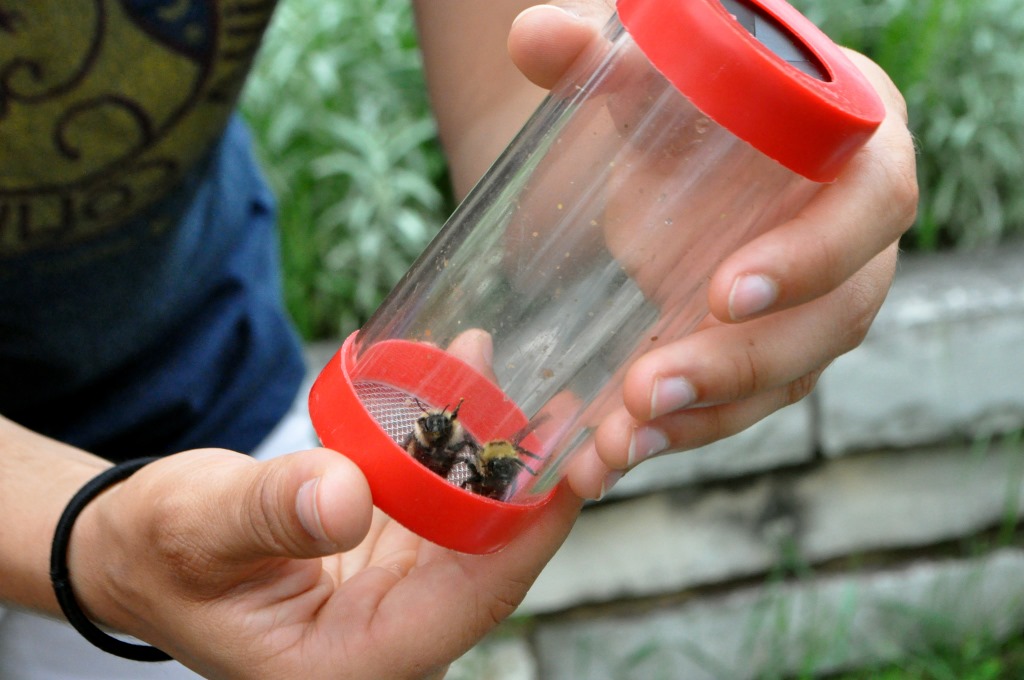
Two bees are captured and identified during the 2015 Bee Fest at the University of Wisconsin-Madison Arboretum in June. Wisconsin is proposing a plan to protect bees, but some critics question whether it does enough to discourage pesticide use tied to bee colony die-offs. Photo by Marion Ceraso for the Wisconsin Center for Investigative Journalism.
Steve Groff, a farmer and seed dealer in Pennsylvania, said neonics have their place but have been “way overused.” He recently began an experiment with support from Penn State to see if planting neonic-free corn seed would protect the beneficial insects that prey on the slugs that can destroy his corn.
The experiment was successful, Groff said. “We started seeing that when we planted green, we had less slug pressure.”
By using alternative farming strategies, such as crop rotation, cover cropping and not tilling soil, Groff said he has reduced his insecticide use by 80 percent. He plans to experiment again this year with a larger plot of neonic-free corn seed.
Plan calls for voluntary measures
The 2015 federal plan that encourages states to develop their own pollinator plans has limited discussion about the role of neonics, Gratton and Locke agreed.
“There is probably a reason the White House report includes very little on pesticides,” Gratton said. “Companies that sell insecticides will make a lot of money on seeds. The agrochemical sector is very powerful.”
At the opening of the first stakeholder meeting last year, Mike Murray of DATCP’s pesticide program told the assembled group, “We’re talking about voluntary actions, we’re not on a regulatory track here.”
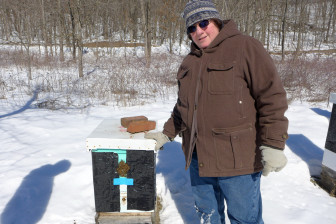
Farmer and beekeepr Harriet Behar stands with one of the 25 beehives she maintains on her farm in Crawford County. She would prefer Wisconsin to draw up a tougher plan for protecting bees, butterflies and other pollinators that would discourage pesticide use. Photo by Bridgit Bowden of Wisconsin Public Radio.
Donna Gilson, spokesperson for DATCP, also said the agency lacks the resources to do research on pesticides, so it follows EPA’s lead on regulating them.
An EPA analysis of neonic use on soy concluded that “in most cases, there is no difference in soybean yield when soybean seed was treated with neonicotinoids versus not receiving any insect control treatment.” Yet those findings have spurred no restrictions on the use of neonic-treated seed for soy by the EPA or DATCP.
For Gratton, a restriction on neonics would raise the concern that farmers might revert to older, more toxic pesticides. “A more nuanced strategy,” Gratton said, “may be both more palatable and get you the same result in terms of protecting pollinators and not impacting yields.”
Crackdown on neonics
Other states and countries have taken a more aggressive approach.
After a number of neonic-related bee death incidents, Oregon banned the application of any product containing the neonics dinotefuran, imidacloprid, thiamethoxam and clothianidin on some flowering trees.
Minnesota’s pollinator plan committed to a review of the risks of neonic use, including negative impacts on pollinators, the development of resistance in targeted pest insects and leaching into soil and water.
The government of Ontario, Canada, has moved to reduce the use of neonic-treated seed for corn and soybean crops by 80 percent by 2017.
Aimee Code thinks Wisconsin’s plan should include stronger measures.
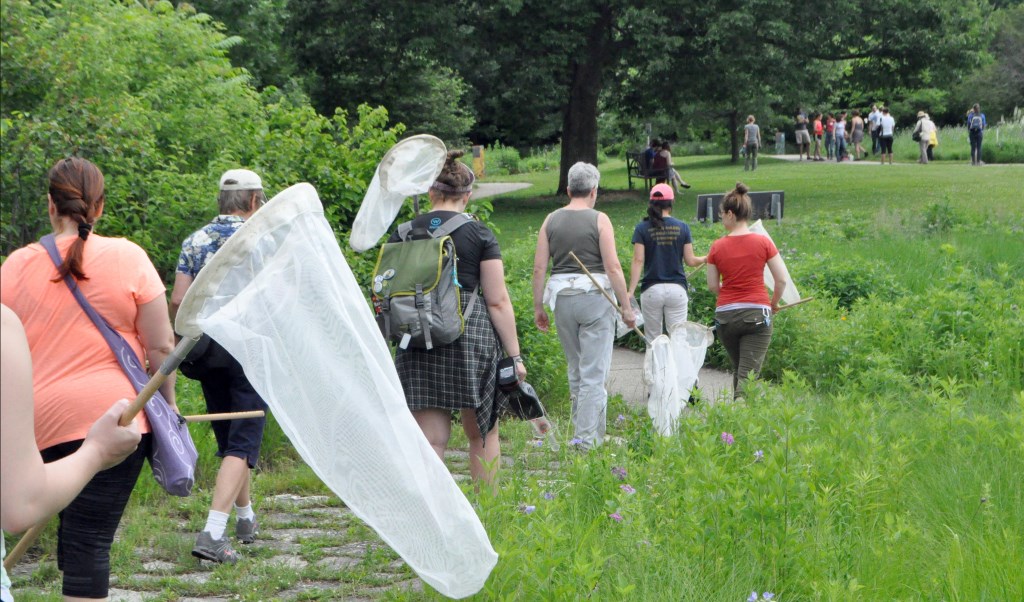
Attendees at the 2015 Bee Fest at the University of Wisconsin-Madison Arboretum set out to catch and identify bees. Wisconsin has among the highest annual loss rate of managed honeybees in the country. Photo by Marion Ceraso for the Wisconsin Center for Investigative Journalism.
“We don’t think it’s appropriate to stay quiet when the science is showing that there is an issue with neonics,” said Code, a pesticide expert with the Xerces Society for Invertebrate Conservation, one of the invited stakeholder organizations.
Code said given the widespread preventative use of neonics, Wisconsin’s plan should include requirements for scouting and monitoring fields to ensure there is a pest problem before coated seeds get planted.
“We should be promoting verification of need before use within our pesticide regulation,” she said.
For her part, Harriet Behar, the Crawford County farmer and beekeeper, wants to see “a plan with some teeth in it.”
“Neonics have allowed people to ignore good agronomic processes,” she said. “We don’t have to rotate crops anymore. We just kill everything off with neonics. If we make conservation crop rotation a big push in Wisconsin, so farmers don’t have the pest and disease problems they are currently trying to solve with neonics, that would be a big help.”
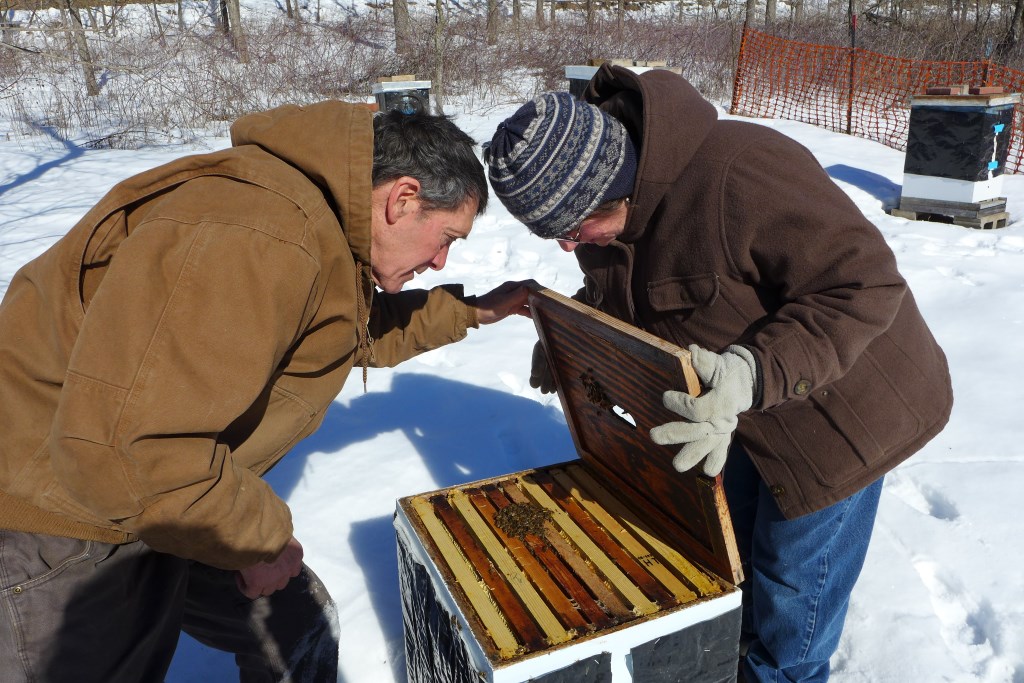
Farmer and beekeeper Harriet Behar and her husband Aaron Brin check on the bees at Behar’s Crawford County farm. Behar has 25 beehives on her 216-acre farm in southwestern Wisconsin. Photo by Bridgit Bowden of Wisconsin Public Radio.
Companies may already be moving on to the next new pesticide. Critics call it a pesticide shell game; agrochemical companies describe it as innovation.
“As concerns are raised, companies always have a new product to replace one which is going out,” said Lex Horan, of the advocacy organization Pesticide Action Network, which works to reduce pesticide use.
In fact, DuPont Pioneer recently announced it had developed a new systemic seed treatment called Lumivia for corn pests which, according to company spokeswoman Jane Slusark, has “low to no impact on pollinators.”
Marion Ceraso is a freelance journalist who holds master’s degrees in public health from the Johns Hopkins Bloomberg School of Public Health and in journalism from the University of Wisconsin-Madison. The nonprofit Wisconsin Center for Investigative Journalism (www.WisconsinWatch.org) collaborates with Wisconsin Public Radio, Wisconsin Public Television, other news media and the UW-Madison School of Journalism and Mass Communication. All works created, published, posted or disseminated by the Center do not necessarily reflect the views or opinions of UW-Madison or any of its affiliates.
-
Wisconsin’s Medicaid Postpartum Protection Lags Most States
 Feb 27th, 2024 by Rachel Hale
Feb 27th, 2024 by Rachel Hale
-
Wisconsin Has A “Smart Growth” Law To Encourage Housing, But No One Is Enforcing It
 Dec 22nd, 2023 by Jonmaesha Beltran
Dec 22nd, 2023 by Jonmaesha Beltran
-
Milwaukee County Is Funding Affordable Housing In Suburbs
 Dec 21st, 2023 by Jonmaesha Beltran
Dec 21st, 2023 by Jonmaesha Beltran
















The pesticide is freely used in flowers purchased at most garden centers brought in from other states.
I have planted half my yard and the adjacent Milwaukee County Holler Park with over 30,000 native prairie plants and grasses. There are literally thousands of native bees, honey bees, Moth Humming Birds, Hummingbirds, insects and birds feasting on nectar, seeds, and habitat. Part of my daily dog walk is checking up on the gardens of new growth and wildlife that visits.